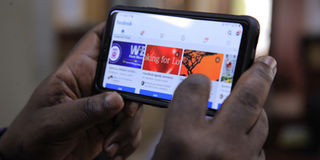Major perceptions about megapixels

A customer using a smartphone. Image quality and low light performance suffers in smartphone cameras. PHOTO | RACHEL MABALA
Any photoholic often looks for the highest Megapixel (MP) in a smartphone or a DSLR camera.
Professional photo-journalist Rachel Mabala at Daily Monitor, says, “The resolution of a phone camera is measured in megapixel which means one million pixels. If I buy a smartphone, I will always look into the pixel size in a camera.”
Every year when the mobile market players launch a new smartphone with an updated megapixel size, some consumers find the current one to be obsolete and fall prey to own the best, no matter the stated price.
However, the megapixel size does not matter and it is a hype.
What is a pixel and megapixel?
The term pixel stands for Picture Element. Pictures are made up of little dots called pixels that are arranged horizontally and vertically.
Pixel Count, expressed as Megapixels, is nothing but multiplying the number of horizontal pixels by the number of vertical pixels. It is exactly like calculating an area. To put it simply, a single megapixel amounts to exactly one million pixels in an image.
For example, a 3MP camera has 2,048 (horizontal) x 1,536 (vertical) pixels, or 3,145,728 pixels. Which we simply call 3MP.
Speaking to the Prosper, Mr Remmegious Ssewankambo, the senior executive director at Techjaja said, “Yes, megapixel count but they don’t necessarily measure up in terms of the picture quality,. Rather, it’s the work of the sensor in regards to its size, light and the optimisation done to the software to get the best result.”
Smartphone developers are on a constant struggle to bring out the larger megapixel. But does that really make a difference? For example, let us look at a typical DSLR (Digital Single Lens Reflex) camera, it can have least of 8 megapixels to 50.6 megapixels whereas the latest model of Xiaomi smartphone camera has a huge 108-megapixel camera in its tiny body.
Does this mean the Xiaomi is going to take better pictures than a DSLR camera? Yes, it can to a certain extent. But since the DSLR has a better and good sensor, it will overpower the latter.
It is important to understand how a camera’s sensor and number of megapixels can impact your photos for better or worse.
Expounding more on this, Mr Eric Dominic Bukenya, the multimedia editor at Daily Monitor says, “Pixels in a smartphone aren’t the same as those in a DSLR camera. I see some smartphones with 36MP and many pro DSLR cameras have 26MP. This doesn’t mean that the phone with 36MP will take a better image than a camera with 26MP or less. It is the sensor that makes a difference.”
What are sensors?
Technically, there is much more to just the number of pixels that make up the sensor. There is also the size of the sensor. Digital cameras and smart phone cameras contain a sensor to capture an image. These sensors, in turn, are made up of small photosites.
A photosite is nothing but a sensor for every unique pixel. When the sensor is exposed, each little photosite receives light which is translated as colour in your final picture.
The more the number of photosites on a camera, the better the resolution. A sensor that has 1,000,000 photosites will have a million pixels to capture the detail in form of colour. So, if one has 13-megapixel camera, it means the image sensor on that camera has 13,000,000 photosites .
To take a picture, the camera should absorb the light through the lens on the sensor.
Typically, the more the light, the better the resulting image the sensor perceives.
Highlighting the importance of the sensor, Mr Bukenya says, “The sensor is like the heart of the camera. It determines the performance of the camera in different conditions, say in low light conditions. So, a camera with a very good sensor is far better than one with lots of megapixels.”
Any distortion or noise on your image is due to low less light while clicking a picture. A camera with higher megapixel and a low sensor can make the camera work too hard to get enough light to generate a good picture.
This is when a good sensor comes in. Sensors are of two categories, CCD (Charge-Couple Device) sensor is slightly smaller and it is found in most compact smartphone cameras and many DSLR as well. CMOS (Complementary Metal Oxide Semi-conductor) is found in high end DSLR’s and is larger with the ability to capture more light.
Sensors come in various sizes. A smartphone sensor is much smaller than one in a DSLR with full frame sensors.Larger sensors come in the size of 36mm x 24mm.
In other words, it is a full frame sensor. The bigger camera sensor will take up more space in your device, and need a bigger lens to cast an image. Most smartphones including the iPhone 5 use a tiny 1/3.2-inch image sensor.
In real terms, this measures just 4.54 x 3.42 mm and explains how they keep devices very slim and light. This also explains why image quality and low light performance suffers, when they can have as many as 12 megapixels.
So, “One has to look for the larger sensor size rather than the megapixel count to buy a smartphone,” says Mr Bukenya.




